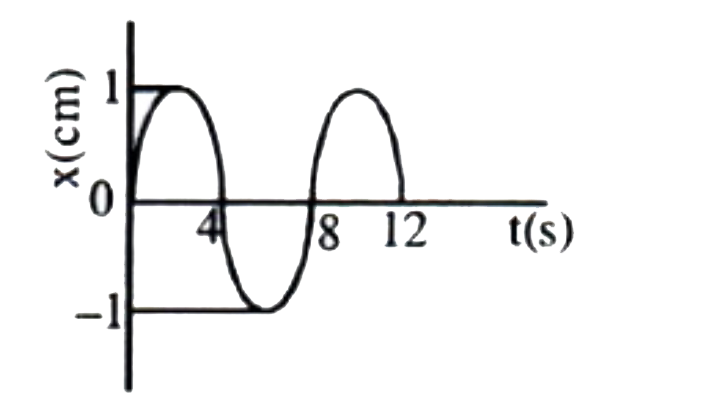The number of independent constituent simple harmonic motions yielding a resultant displacement equation of the periodic motion as is
8
6
4
3
The correct Answer is:D
To solve the problem, we need to analyze the given displacement equation of the periodic motion, which is:
y=8sin2(t2)sin(10t)
We will break down the equation step by step to identify the number of independent constituent simple harmonic motions.
Step 1: Rewrite the Equation
We start with the equation:
y=8sin2(t2)sin(10t)
We can factor out the constants:
y=4⋅2sin2(t2)sin(10t)
Step 2: Use Trigonometric Identity
Next, we apply the trigonometric identity for sin2(t2):
sin2(t2)=1−cos(t)2
Substituting this identity into our equation gives:
y=4⋅2⋅1−cos(t)2⋅sin(10t)
This simplifies to:
y=4(1−cos(t))sin(10t)
Step 3: Expand the Equation
Now we can expand the equation:
y=4sin(10t)−4cos(t)sin(10t)
Step 4: Use Another Trigonometric Identity
We will now use the identity for the product of sine and cosine:
2sinAcosB=sin(A+B)+sin(A−B)
In our case, we can express −4cos(t)sin(10t) as:
−2⋅2sin(10t)cos(t)=−2(sin(10t+t)+sin(10t−t))
This gives us:
y=4sin(10t)−2sin(11t)−2sin(9t)
Step 5: Identify Independent SHMs
From the final expression:
y=4sin(10t)−2sin(11t)−2sin(9t)
We can see that there are three distinct sine terms:
1. 4sin(10t)
2. −2sin(11t)
3. −2sin(9t)
Each sine term represents an independent simple harmonic motion.
Conclusion
Thus, the number of independent constituent simple harmonic motions is 3.
We start with the equation:
Next, we apply the trigonometric identity for sin2(t2):
Now we can expand the equation:
We will now use the identity for the product of sine and cosine:
From the final expression:
2. −2sin(11t)
3. −2sin(9t)
Thus, the number of independent constituent simple harmonic motions is 3.
Topper's Solved these Questions
- LINEAR AND ANGULAR SIMPLE HARMONIC MOTIONBOOK - CENGAGE PHYSICS ENGLISHCHAPTER - LINEAR AND ANGULAR SIMPLE HARMONIC MOTIONEXERCISE - Multiple Correct
35 Videos
- LINEAR AND ANGULAR SIMPLE HARMONIC MOTIONBOOK - CENGAGE PHYSICS ENGLISHCHAPTER - LINEAR AND ANGULAR SIMPLE HARMONIC MOTIONEXERCISE - Assertion Reasoning
6 Videos
- LINEAR AND ANGULAR SIMPLE HARMONIC MOTIONBOOK - CENGAGE PHYSICS ENGLISHCHAPTER - LINEAR AND ANGULAR SIMPLE HARMONIC MOTIONEXERCISE - Subjective
21 Videos
- KINETIC THEORY OF GASES AND FIRST LAW OF THERMODYNAMICSBOOK - CENGAGE PHYSICS ENGLISHCHAPTER - KINETIC THEORY OF GASES AND FIRST LAW OF THERMODYNAMICSEXERCISE - Interger
11 Videos
- MISCELLANEOUS KINEMATICSBOOK - CENGAGE PHYSICS ENGLISHCHAPTER - MISCELLANEOUS KINEMATICSEXERCISE - Interger type
3 Videos
Similar Questions
Knowledge Check
The differential equation of a particle executing simple harmonic motion along y-axis is
Ad2ydt2+ω2y=0Bd2ydt2+ω2y2=0Cd2ydt2−ω2y=0Ddydt+ωy=0The displacement of a particle executing simple harmonic motion is given by y=4sin(2t+ϕ). The period of oscillation is
A2/πBπ/2CπD2πA particle executing simple harmonic motion with time period T. the time period with which its kinetic energy oscillates is
ATB2TC4TDT2
The x-t graph of a particle undergoing simple harmonic motion is shown below. The acceleration of the particle at t=23s is

View SolutionA particle is executing simple harmonic motion with an amplitude A and time period T. The displacement of the particles after 2T period from its initial position is
View SolutionWhich of the following functions of time represent (a) simple harmonic motion and (b) periodic but not simple harmonic motion? Give the period for each case.
(i)sinωt−cosωt (ii) sin2ωt (iii) cosωt+2sin2ωt
View SolutionIf particle is excuting simple harmonic motion with time period T, then the time period of its total mechanical energy is :-
View SolutionWhich of the following functions of time represent (a) simple harmonic motion and (b) periodic but not simple harmonic motion? Give the period for each case.
(i)sinωt−cosωt (ii) sin2ωt (iii) cosωt+2sin2ωt
View Solution
